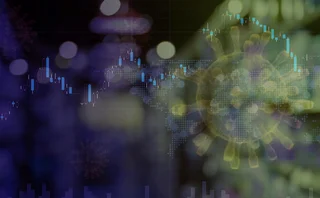
Credit dries up in shipping industry
Letters of credit, a form of guarantee that are fundamental to world trade, have become increasingly hard to secure, as lack of confidence in financial institutions spills over into the shipping industry.
Banks supply letters of credit to alleviate the risk of a counterparty either failing to deliver goods or failing to pay for them, effectively guaranteeing both sides of the transaction.
When interbank lending markets began to seize up following the bankruptcy of Lehman Brothers on September 15, it did not take long for this crisis of confidence to filter through to the shipping industry.
“[Lehman’s bankruptcy] was obviously the first stepping stone towards where we are now,” said Matthew Wright, a dry freight analyst at the London shipbrokers Icap Shipping, “although it only got severely worse at the end of September and beginning of October”.
Confidence seeped away as counterparties and their respective banks began to lose trust in one another. Meanwhile, banks lacking liquidity were less willing to issue credit and consequently the price of letters of credit soared.
"[Prices have risen] 40% in the last few weeks and threefold over the last year," confirmed Wright.
Analysts cite dry bulk commodities –such as grain, coal and iron ore – as being the worst hit, as these tend to be transported by smaller shippers reliant on bank guarantees. The oil shipping sector has been less affected.
The Baltic Dry Index (BDI), a daily average of the cost of shipping raw materials, has plummeted recently, falling from a high of 11,793 on May 20 to 925 today. This reflects the lack of easily available credit and a drop in underlying demand for raw materials as the world economy slows. Both developments are endangering shipowners, traders say.
“It’s looking a bit bleak on a short term basis, that’s for sure,” commented Bjørn Strømsnes, global head of dry freight derivatives at Imarex, a Norwegian freight derivatives company. “There are fears of potential defaults coming, although we haven’t seen many of them yet.”
Industrial Carriers, a Ukrainian shipper of coal, ore and grains, is one such example, filing for bankruptcy in mid October. Elsewhere, Fortescue Metals Group, the Australian iron ore exporter, faces a “significant risk” of Asian clients canceling shipments, according to a Citigroup report; and Britannia Bulk, a coal freighter, has said there is a “very high risk” it will default on its loan agreements.
Responses to the crisis have been swift. On October 9, the World Bank’s International Finance Corporation expanded its trade finance program by $500 million to $1.5 billion. The next day, Pascal Lamy, director general of the WTO, announced a conference to be held on November 12 to reinforce "confidence in global co-operation and institutions".
“The industry, including Imarex, is working around different ways of trying to get legacy deals converted from over the counter to central clearing,” added Strømsnes. “But there are still outstanding issues and a lot of work is being done [on them]”.
Despite the recent turmoil, there is evidence the crisis will be resolved quickly. Interbank lending has already begun to ease substantially; both Wright and Strømsnes agree that this liquidity will eventually filter through to shipping. Wright pointed out, too, that the plunge in the BDI has brought it back closer to historical levels after a dramatic spike.
“The shipping boom of the last few years is well off the scale compared to the previous 30 or 40 years,” explained Wright (until 2004 the BDI had remained constant around 1700). “We’re at rock bottom at the moment. The only way is up."
“In the short term we may struggle a bit,” concurred Strømsnes, “but we expect to see a recovery by Q1, Q2 [2009].”
See also: The state of freight
Fluctuating tides
Only users who have a paid subscription or are part of a corporate subscription are able to print or copy content.
To access these options, along with all other subscription benefits, please contact info@risk.net or view our subscription options here: http://subscriptions.risk.net/subscribe
You are currently unable to print this content. Please contact info@risk.net to find out more.
You are currently unable to copy this content. Please contact info@risk.net to find out more.
Copyright Infopro Digital Limited. All rights reserved.
You may share this content using our article tools. Printing this content is for the sole use of the Authorised User (named subscriber), as outlined in our terms and conditions - https://www.infopro-insight.com/terms-conditions/insight-subscriptions/
If you would like to purchase additional rights please email info@risk.net
Copyright Infopro Digital Limited. All rights reserved.
You may share this content using our article tools. Copying this content is for the sole use of the Authorised User (named subscriber), as outlined in our terms and conditions - https://www.infopro-insight.com/terms-conditions/insight-subscriptions/
If you would like to purchase additional rights please email info@risk.net
More on Energy
Energy Risk Commodity Rankings 2024: markets buffeted by geopolitics and economic woes
Winners of the 2024 Commodity Rankings steeled clients to navigate competing forces
Chartis Energy50
The latest iteration of Chartis’ Energy50 ranking
Energy trade surveillance solutions 2023: market and vendor landscape
The market for energy trading surveillance solutions, though small, is expanding as specialist vendors emerge, catering to diverse geographies and market specifics. These vendors, which originate from various sectors, contribute further to the market’s…
Achieving net zero with carbon offsets: best practices and what to avoid
A survey by Risk.net and ION Commodities found that firms are wary of using carbon offsets in their net-zero strategies. While this is understandable, given the reputational risk of many offset projects, it is likely to be extremely difficult and more…
Chartis Energy50 2023
The latest iteration of Chartis' Energy50 2023 ranking and report considers the key issues in today’s energy space, and assesses the vendors operating within it
ION Commodities: spotlight on risk management trends
Energy Risk Software Rankings and awards winner’s interview: ION Commodities
Lacima’s models stand the test of major risk events
Lacima’s consistent approach between trading and risk has allowed it to dominate the enterprise risk software analytics and metrics categories for nearly a decade
2021 brings big changes to the carbon market landscape
ZE PowerGroup Inc. explores how newly launched emissions trading systems, recently established task forces, upcoming initiatives and the new US President, Joe Biden, and his administration can further the drive towards tackling the climate crisis
Most read
- Top 10 operational risks for 2024
- Top 10 op risks: third parties stoke cyber risk
- Japanese megabanks shun internal models as FRTB bites







